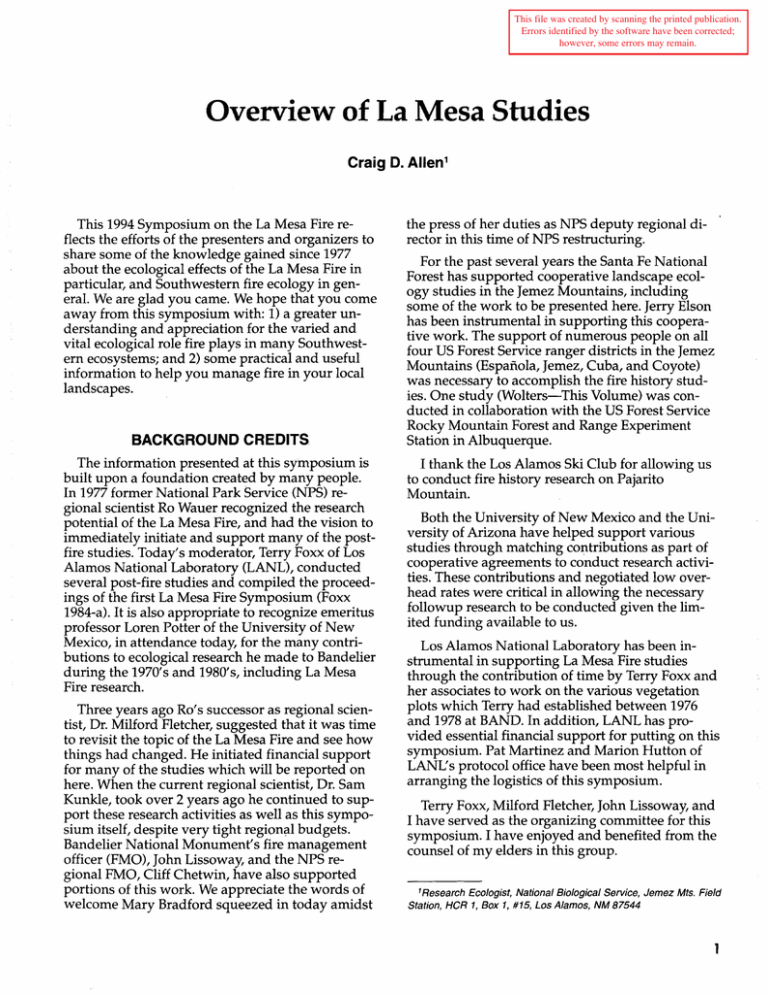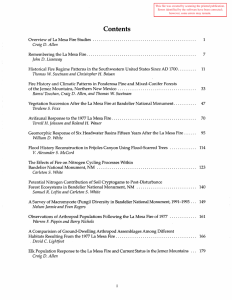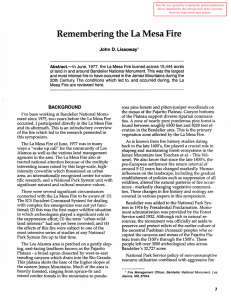Overview of La Mesa Studies
advertisement

This file was created by scanning the printed publication. Errors identified by the software have been corrected; however, some errors may remain. Overview of La Mesa Studies Craig D. Allen 1 This 1994 Symposium on the La Mesa Fire reflects the efforts of the presenters and organizers to share some of the know ledge gained since 1977 about the ecological effects of the La Mesa Fire in particular, and Southwestern fire ecology in general. We are glad you came. We hope that you come away from this symposium with: 1) a greater understanding and appreciation for the varied and vital ecological role fire plays in many Southwestern ecosystems; and 2) some practical and useful information to help you manage fire in your local landscapes. BACKGROUND CREDITS The information presented at this symposium is built upon a foundation created by many people. In 1977 former National Park Service (NPS) regional scientist Ro Wauer recognized the research potential of the La Mesa Fire, and had the vision to immediately initiate and support many of the postfire studies. Today's moderator, Terry Foxx of Los Alamos National Laboratory (LANL), conducted ~everal post~fire studies and compiled the proceedIngs of the fIrst La Mesa Fire Symposium (Foxx 1984-a). It is also appropriate to recognize emeritus professor Loren Potter of the University of New Mexico, in attendance today, for the many contribu tions to ecological research he made to Bandelier during the 1970's and 1980's, including La Mesa Fire research. Three years ago Ro's successor as regional scientist, Dr. Milford Fletcher, suggested that it was time to revisit the topic of the La Mesa Fire and see how things had changed. He initiated financial support for many of the studies which will be reported on here. When the current regional scientist, Dr. Sam Kunkle, took over 2 years ago he continued to supp.ort t~ese resear~h activities as well as this sympoSIum Itself, despIte very tight regionClI budgets. Bandelier National Monument's fire management o~ficer (FMO), John Lissoway, and the NPS regIonal FMO, Cliff Chetwin, have also supported portions of this work. We appreciate the words of welcome Mary Bradford squeezed in today amidst the press of her duties as NPS deputy regional di- ' rector in this time of NPS restructuring. For the past several years the Santa Fe National Forest ha.s s~pported cooperative landscape ecology studIes In the Jemez Mountains, including some of t~e work to be presented here. Jerry Elson has been Instrumental in supporting this cooperative work. The support of numerous people on all four US Forest Service ranger districts in the Jemez Mountains (Espanola, Jemez, Cuba, and Coyote) ~as necessary to accomplish the fire history studIes. One study (Wolters-This Volume) was conducted in collaboration with the US Forest Service Rocky Mountain Forest and Range Experiment Station in Albuquerque. I thank th~ Lo~ Alamos Ski Club for allowing us to conduct fIre hIStOry research on Pajarito Mountain. Both the University of New Mexico and the University of Arizona have helped support various studies t~rough matching contributions as part of cooperatIve agreements to conduct research activities. These contributions and negotiated low overhead rates were critical in allowing the necessary followup research to be conducted given the limited funding available to us. Los Alamos National Laboratory has been instrumental in supporting La Mesa Fire studies through the contribution of time by Terry Foxx and her associates to work on the various vegetation plots which Terry had established between 1976 and 1978 at BAND. In addition, LANL has provided essential financial support for putting on this symposium. Pat Martinez and Marion Hutton of LANL's protocol office have been most helpful in arranging the logistics of this symposium. Terry Foxx, Milford Fletcher, John Lissoway, and I have served as the organizing committee for this symposium. I have enjoyed and benefited from the counsel of my elders in this group. 1Research Ecologist, National Biological Service, Jemez Mts. Field Station, HeR 1, Box 1, #15, Los Alamos, NM 87544 1 Finally, I am pleased to recognize the assistance provided by many members of Bandelier National Monument's staff in recent years. Certainly recent park management, notably superintendent Roy Weaver and chief of resources management Charisse Sydoriak, have encouraged and supported our efforts to study La Mesa Fire effects. Without John Lissoway's vital support several years ago the current ecological research program at Bandelier would not have developed. The fire crew at Bandelier has helped our work numerous times, especially David Garcia, Merry Beyler, and Chris Chiverton. Members of the administrative group, notably Tammy Gallegos and Eiko Adkisson, have supported the variety of contracting and procurement activities necessary to conduct all this work. Kee Elsisie, Manuel DeVargas, and Moon Almanzar have provided essential horse-packing support when needed. Carlos Gonzales and Moon are clearing the fresh snow from Ponderosa Campground's parking area now so that the field trip can proceed this afternoon. A number of seasonal resource management employees and volunteers have worked with various researchers and helped collect data, notably John Hogan, Kay Beeley, Geneva Chong, and Doug Thayer. Really, almost everyone at Bandelier has helped facilitate portions of this work at one time or another. However, I wish to especially recognize Kay Beeley for her extraordinary and varied support efforts, from conducting and overseeing fieldwork to data analysis and creating graphics to handling the bulk of the registration and mailing work for the symposium. Kay has kept me and symposium planning activities on track. Thank you, Kay. EARLIER LA MESA FIRE STUDIES The first La Mesa Fire Symposium took place October 6-7, 1981, here in Los Alamos. The symposium proceedings (Foxx 1984-a), now out of print, present much of the earlier work. Table 1 outlines the earlier studies, which are summarized below. Foxx's introductory chapter (1984-b) presents background information on the landforms and climate of this area, as well as a detailed description of the La Mesa Fire itself. Wauer and Johnson (1984) studied liLa Mesa Fire Effects on Avifauna" by following changes in breeding bird communities along four transects established before the fire by Wauer. The mile-long transects are arrayed across an elevational gradient, with one each on Frijoles, Burnt, Escobas, and 2 Table 1. La Mesa Fire studies. Names of participants in the 1981 symposium are in italics, while those involved in both 1981 and 1994 symposiums are bolded. "Year(s)" indicates the 19_ year(s) that fieldwork was conducted. Topic Investigator(s) Year(s) Birds Wauer, Johnson 77,78,79,81,83,91 Erosion W.White 77,78,79,80,92,93 Vegetation succession Foxx, Potter 76,77,78,85,93 Grass/tree competition Barnes 80 Elk Cryptogams White Sivinski, Conley Weber Rowland Wolters Allen Freeman C.White Loftin, C.White 77-91 77-79 79,80 80 92-94 90-95 78 92,93 93 Fungi Jarmie, Rogers 92-94 Arthropods Pippin, Nichols Lightfoot Potter, Foxx Touchan, Allen, Swetnam Traylor et al. 77,78 93 76-78 Water Quality Purtymun 77,78 Floods McCord 90-93 Small mammals Guthrie 77-79 Tree clearing Moeur, Guthrie 79 Nitrogen cycle Fire history Archeological sites 91-93 77,78 Apache Mesas. These transects provided a spatial framework around which many of the other studies were conducted, as all but the Frijoles transect were burned by the La Mesa Fire. Wauer and Johnson (1984) provided detailed documentation of post-fire changes in the avifauna which are now best summarized in the followup work by Johnson and Wauer (This Volume). As they state (This Volume): Species diversity increased after the fire, but breeding populations generally declined for several years before increasing above prefire levels. This temporary population decline was more pronounced and lasted longer on the more severely burned transects ... Even an uncontrolled crown fire such as the La Mesa Fire can increase the diversity and population of breeding birds. White and Wells (1984) studied the "Geomorphic Effects of La Mesa Fire" in six small watersheds on Burnt and Apache Mesas-this work also comprised W. White's 1981 master's thesis work. They show that water runoff in the Frijoles watershed became "flashier" after the fire due to the loss of vegetation and litter ground cover. They determined that the amount of post-fire erosion depended upon upslope catchment area, slope steepness and shape, amount of vegetation regrowth, and most importantly, the degree to which impermeable ash layers developed. They found that the higher elevation sites on Apache Mesa had largely stabilized within lwo years due to the rapid recovery of vegetation cover. William White (This Volume) follows the recovery of these watersheds into the 1990's. Foxx and Potter (1984) reviewed "Fire Ecology at Bandelier National Monument." Their fire scar analyses at that time indicated a mean fire interval of 15.1 years for the Escobas Mesa area, with a major decline in fire frequency after 1893. Subsequently, more extensive fire scar sampling (Allen 1989; Touchan et al.-This Volume) suggests pre1900 fire return intervals of about 7 years for the La Mesa Fire area. Foxx and Potter's compilation and analysis of the historic fire record at Bandelier shows that 86% of the fires were lightni~g caused, with two-thirds of fires occurring in t~e May-July period and 87% between May and August. They found that intensity of tree damage from the La Mesa Fire was related to the time since the last previous fire. Foxx (This Volume) follows up on some of these initial findings. They conducted several related studies, including Foxx and Potter (1978), Potter and Foxx (1986), Foxx (1983), and Potter et al. (1982). Potter and Foxx (1984) also presented their findings on "Post-Fire Recovery and Mortality of the Ponderosa Pine Forest After the La Mesa Fire" . Their map of post-fire foliar damage classes remains the best assessment of La Mesa Fire burn intensities. They marked and followed 897 trees in 9 plots. All 504 trees lacking any green needles immediately after the fire were dead, while of the 393 trees which still had green needles after the fire, 357 (91 %) remained alive after two growing seasons. They found 80% survival of even those trees with more than 50% singed needles. Up to 7100 shrub sprouts / acre were observed, mostly Robinia neomexicana and Quercus gambelli. They document the increased establishment of aerially seeded grasses where native grass density was lowest, also finding that ponderosa pine needlefall enhanced germination but diminished the vigor of seeded grasses. Barnes (1984) treated the "Water Relations of the Dominant Grasses on La Mesa Burn." She demonstrated that the seeded grasses sheep fescue (Festuca ovina) and slender wheatgrass (Agropyron trachycaulum) compete more intensely with ponderosa pine seedlings for water than the most common native grass, mountain muhly (Muhlenbergia montana). This greater competition is attributed to both the spring-growth phenology and shallow, mat-like rooting habits of these seeded grasses. Freeman (1984) considered "The Effect of La Mesa Fire on Total Soil Nitrogen in Bandelier N ational Monument, New Mexico." He estimated that the La Mesa Fire caused losses of 45-65% of the total soil nitrogen. Traylor (1984) studied the "Effects of La Mesa Fire on Bandelier's Cultural Resources," later published in greater detail as Traylor et al. (1990). The insistence upon the participation of archeologists in the firefighting efforts of the La Mesa Fire was a first for a major fire suppression effort, and it won the park superintendent a Department of Interior award. Nonetheless, Traylor et al.' s classic work documents how fire suppression activities damage archeological sites, even when archeologists are working together with fire crews to try to avoid site impacts. They found that 44 of the 100 archeological sites they studied after the fire had been damaged by fire suppression-related activities, especially the construction and rehabilitation of bulldozer-constructed firelines. Damage to cultural sites from the fire itself ranged from light to severe, depending upon the intensity, duration, and penetration of heat, which was largely a function of the amount of fuel present on a site. Documented examples of fire damage included spalling of tuff building blocks, carbonized or oxidized ceramics, heat alteration of obsidian, and the destruction of on-site pollen. Purtymun (1984) assessed changes in the "Chemical Quality of Surface Water in Bandelier National Monument" caused by the La Mesa Fire in Frijoles, Alamo, and Capulin Creeks. He found that the fire induced increases in calcium, chloride, bicarbonate, and total dissolved solids, with declines to roughly pre-fire levels within 20 months post-fire. Pippin and Pippin (1984) present an inventory report on the"Aquatic Invertebrates from Capulin Creek, Bandelier National Monument." They found 65 taxa, compared to 107 taxa found in the more voluminous Frijoles Creek. This report was apparently inadvertently published in the symposium proceedings instead of the Pippin and Nichols (This Volume) work on "Observations of Arthropod Populations Following the Bandelier 3 National Monument Fire of 1977," which was presented at the 1981 symposium. Table 2. Schedule, La Mesa Fire Symposium, March 29-31, 1994. Guthrie (1984) studied the "Effects of Fire on Small Mammals within Bandelier National Monument." The fire directly killed many arboreal squirrels (Sciurus and Tamiasciurus spp.) and chipmunks (Eutamias spp.), as well as some mice (Peromyscus spp.), although most burrowing mammals survived. Taxa which decreased after the fire included pinyon mice (Peromyscus truei) and red squirrels (Tamiasciurus hudsonicus). Deer mice (Peromyscus maniculatus) increased in all burned areas, along with voles (Microtus spp.) in grassy habitats and chipmunks in ponderosa pine and mixed conifer forests. Guthrie also documented winter-caused reductions of 50-90% in local small mammal populations. 9:00 10:00 Moeur and Guthrie (1984) examined the "Effects of Clearing Fire-Killed Trees on Wildlife" in the upper Frijoles Mesa area, comparing an unmanipulated Bandelier National Monument site to a salvage-logged site across the road on LANL land. In the summer of 1979 they found slightly more herbaceous cover on the Bandelier ~ite, and no differences in insect or small mammal populations between sites. They document greater diversity and abundance of birds on the Bandelier site, presumably due to the increased structural diversity of the habitat where dead and downed trees were left in place. 10:15-11 :00 Several other studies of the ecological effects of the La Mesa Fire were conducted but not written up for the symposium proceedings. Sivinski (1979) and Conley et a1. (1979) used a network of 70 pellet transects in Bandelier to document "Responses of elk and mule deer to wildfire: Changes in utilization and migration patterns." They found low initial numbers of elk in fall 1977, with continuous increases through 1979. During that time they believed that 100 to 300 elk used Bandelier, and then only in winter, with use focused in the La Mesa Fire area. 4:15-4:45 Three companion studies on elk were presented at the 1981 symposium but published elsewhere. G. White (1981) used "Biotelemetry Studies on Elk" to show that local elk used burned areas heavily in the winter, especially the La Mesa Fire area. Rowland (1981) and Rowland et a1. (1983) studied comparative winter diets of elk wintering in Bandelier's La Mesa Fire area and an unburned area on the Baca Ranch. The seeded grass sheep fescue dominated diets in the burned area, but nearly equal proportions of browse and grass were eaten by the Baca elk. The grass-dominated diet of the Bandelier elk had relatively high digestible 4 10:10 11 :00-12:00 1:30-5:00 8:30-9:00 9:00-9:30 9:30-10:00 11 :00-11 :30 12:45-1 :30 1:30-2: 15 2:30-3:15 3:15-3:30 3:45-4:15 8:30-9:00 9:00-9:30 9:30-10:15 10:30-11 :00 11 :00-11 :30 11 :30-12:00 12:00 TUESDAY 3/29/94 Registration Welcome-Mary Bradford, Deputy Regional Director, NPS Description of the La Mesa Fire, John Lissoway Overview of La Mesa Fire Studies, Craig Allen Field Trip to the La Mesa Fire Area, Terry Foxx, John Lissoway, Craig Allen WEDNESDAY 3/20/94 Tom Swetnam, Temporal and Spatial Variation in Southwestern Fire Regimes Ramzi Touchan, Fire History and Climatic Patterns in Ponderosa and Mixed Conifer Forests of the Jemez Mountains Craig Allen, Fire History and Landscape Change in the Frijoles Watershed, Bandelier National Monument Teralene Foxx, The La Mesa Fire, Seventeen Years After: Post-fire Vegetation Changes Alex McCord, Flood History Reconstruction in Frijoles Canyon Using Flood-Scarred Trees Carlton S. White, The Effects of Fire on the Nitrogen Cycle Processes in Bandelier National Monument William White, Geomorphic Response of Six Headwater Basins Sixteen Years After the La Mesa Fire Sam Loftin, Potential Nitrogen Contribution of Soil Cryptogams to Post-Disturbance Forest Ecosystems David Lightfoot, A Comparison of Ground-Dwelling Arthropod Assemblages Among Different Habitats Resulting from the 1977 La Mesa Fire Nelson Jarmie, Diversity of Macromycetes in Bandelier National Monument - A Survey Tom Cartledge, Heritage Resources and Fire Management: A Cooperative Co-Existence THURSDAY 3/31194 Craig Allen, Elk Response to the La Mesa Fire and Current Status in the Jemez Mountains Gale Wolters, Elk Effects on Meadows and Grasslands in Bandelier National Monument Terry Johnson, Avifaunal Response After the La Mesa Fire John Peterson (USFS Jemez District Ranger) and John Lissoway, Current US Forest Service and Bandelier National Monument Fire Programs in the Jemez Mountains Charisse Sydoriak (Chief, Resources Management, Bandelier), Bandelier's Fire Monitoring Program Milford Fletcher and Craig Allen, Research Summary and Management Lessons from the La Mesa Fire End energy values, which Weber (1981) and Weber et a1. (1984) showed led to higher body weights and better nutritional status (as determined by blood metabolites). As indicated previously, Pippin and Nichols (This Volume) presented a paper at the 1981 symposium describing "Observations of Arthropod Populations Following the Bandelier National Monument Fire of 1977," but it was inadvertently not included in the proceedings volume. They found that the diversity and abundance of arthropods was markedly reduced in an intensely burned area. RECENT LA MESA FIRE STUDIES As noted earlier, three years ago Milford Fletcher began to support another round of studies on the La Mesa Fire. Most of the work has been conducted the past two field seasons, and we have been fortunate to have several of the original investigators return for long-term followup work on their old topics (Table 1). One component of all the recent studies has been significant efforts to carefully record study site locations and archive all of the collected data at Bandelier, so that future studies can continue to follow the progress of post-fire ecosystem changes. This symposium represents one effort to make current information on fire effects available to resource managers. The symposium schedule (Table 2) illustrates the diversity of studies which have been conducted. The researchers featured here have worked long and hard on their respective projects, particularly given the limited funding which was available. It has been a pleasure to work with this dedicated group of researchers. We hope you find the presented results interesting and useful. LITERATURE CITED Allen, CD. 1989. Changes in the Landscape of the Jemez Mountains, New Mexico. Ph.D. dissertation, Univ. of California, Berkeley, CA. Barnes, EJ. 1984. Water relations of the dominant grasses on La Mesa burn. pp. 57-72 In: T.S. Foxx (compiler), La Mesa Fire Symposium. LA-9236-NERP. Los Alamos National Laboratory, New Mexico. Conley, W., R Sivinski, and G.C White. 1979. Responses of elk (Cervus elaphus) and mule deer (Odocoileus hemionus) to wildfire: Changes in utilization and migration patterns. Unpublished final report to National Park Service, Contract No. CX7029-7-0057, on file at Bandelier National Monument, NM. 44 pp. Foxx, T.S. 1983. Germinant reforestation of ponderosa pine at Bandelier National Monument. Unpublished report on file at Bandelier National Monument, New Mexico. 63 pp. Foxx, T.S. (compiler). 1984-a. La Mesa Fire Symposium, Los Alamos, New Mexico, October 6 and 7, 1981. LA-9236NERP, Los Alamos National Laboratory, Los Alamos, New Mexico. Foxx, T.5. 1984-b. Introduction-La Mesa Fire Symposium. pp. 1-10 In: T.S. Foxx (compiler), La Mesa Fire Symposium. LA-9236-NERP. Los Alamos National Laboratory, New Mexico. Foxx, T.S. This volume. Vegetation Succession After the La Mesa Fire at Bandelier National Monument. Foxx, T.5., and L.D. Potter. 1978. Fire ecology at Bandelier National Monument. Unpublished report on file at Bandelier National Monument, New Mexico. 214 pp. Foxx, T.5., and L.D. Potter. 1984. Fire ecology at Bandelier National Monument. pp. 11-37 In: T.S. Foxx (compiler), La Mesa Fire Symposium. LA-9236-NERP. Los Alamos National Laboratory, New Mexico. Freeman, CE. 1984. pp. 91-96 In: T.S. Foxx (compiler), La Mesa Fire Symposium. LA-9236-NERP. Los Alamos National Laboratory, New Mexico. Guthrie, D.A. 1984. Effects of fire on small mammals within Bandelier National Monument. pp. 115-134 In: T.S. Foxx (compiler), La Mesa Fire Symposium. LA-9236-NERP. Los Alamos National Laboratory, New Mexico. Johnson, T.H., and RH. Wauer. This volume. Avifaunal Response to the 1977 La Mesa Fire. Moer, S., and D.A. Guthrie. 1984. The effects of clearing firekilled trees on wildlife. pp. 135-144 In: T.S. Foxx (compiler), La Mesa Fire Symposium. LA-9236-NERP. Los Alamos National Laboratory, New Mexico. Pippin, W.E, and B. Nichols. This volume. Observations of Arthropod Populations Following the La Mesa Fire of 1977. Pippin, W.R, and B.D. Pippin. 1984. pp. 107-114 In: T.S. Foxx (compiler), La Mesa Fire Symposium. LA-9236-NERP. Los Alamos National Laboratory, New Mexico. Potter, L.D., and T.S. Foxx. 1984. Postfire recovery and mortality of the ponderosa pine forest after La Mesa Fire. pp. 39-56 In: T.S. Foxx (compiler), La Mesa Fire Symposium. LA-9236-NERP. Los Alamos National Laboratory, New Mexico. Potter, L.D., and T.5. Foxx. 1986. Reassessment of vegetational recovery eight years ofter the La Mesa Fire, Bandelier. Unpublished report on file at Bandelier National Monument, New Mexico. 53 pp. Potter, L.D., T.S. Foxx, and EJ. Barnes. 1982. Natural regeneration of ponderosa pine as related to land use and fire history on the Pajarito Plateau. LA-9293-NERP. Los Alamos National Laboratory, New Mexico. 26 pp. Purtymun, W.D. 1984. Chemical quality of surface water in Bandelier National Monument. pp. 103-106 In: T.S. Foxx (compiler), La Mesa Fire Symposium. LA-9236-NERP. Los Alamos National Laboratory, New Mexico. Rowland, M.M. 1981. Comparative winter nutrition of elk in the Jemez Mountains, New Mexico. M.S. thesis, Colorado State Univ., Fort Collins, CO. 83 pp. Rowland, M.M., A.W. Alldredge, J.E. Ellis, B.J. Weber, and G.C White. 1983. Comparative winter diets of elk in New Mexico. J. Wildl. Manage. 47(4):924-932. Sivinski, R 1979. A Multivariate Analysis of Summer Habitat Partitioning Between Elk (Cervus elaphus) and mule deer 5 (Odocoileus hemionus) in Bandelier National Monument, New Mexico. M.S. thesis, New Mexico State Univ., Las Cruces, NM. 43 pp. Touchan, R., CD. Allen, and T.W. Swetnam. This volume. Fire History and Climatic Patterns in Ponderosa Pine and Mixed-Conifer Forests of the Jemez Mountains, Northern New Mexico. Traylor, D. 1984. Effects of La Mesa Fire on Bandelier's cultural resources. pp. 97-102 In: T.S. Foxx (compiler), La Mesa Fire Symposium. LA-9236-NERP. Los Alamos National Laboratory, New Mexico. Traylor, D., 1. Hubbell, N. Wood, and B. Fiedler. 1990. The 1977 La Mesa Fire Study: An Investigation of Fire and Fire Suppression Impact on Cultural Resources in Bandelier National Monument. Southwest Cultural Resources Center Professional Papers No. 28, National Park Service, Santa Fe, NM. 206 pp. Wauer and Johnson. 1984. La Mesa Fire effects on avifauna. pp. 145-172. In: T.S. Foxx (compiler), La Mesa Fire Symposium. LA-9236-NERP. Los Alamos National Laboratory, New Mexico. 6 Weber, B.J. 1981. Physiologic response of elk to differences in winter range quality. M.s. thesis, Utah State Univ., Logan, UT. 86 pp. Weber, B. J., M.L. Wolfe, G.C White, and M.M. Rowland. 1984. Physiologic response of elk to defferences in winter range quality. J. Wildl. Manage. 48(1):248-253. White, G.C 1981. Biotelemetry studies on elk. LA-8529-NERP. Los Alamos National Laboratory, New Mexico. 24 pp. White, W.D. 1981. Effects of Forest-Fire Devegetation on Watershed Geomorphology in Bandelier National Monument. M.S. thesis, Univ. of New Mexico, Albuquerque, NM. 208 pp. White, W.D. This volume. Geomorphic Response of Six Headwater Basins Fifteen Years After the La Mesa Fire. White, W.D., and S.G. Wells. 1984. Geomorphic effects of La Mesa Fire. pp. 73-90. In: T.S. Foxx (compiler), La Mesa Fire Symposium. LA-9236-NERP. Los Alamos National Laboratory, New Mexico. Wolters, G.1. This volume. Elk effects on Bandelier National Monument meadows and grasslands.



